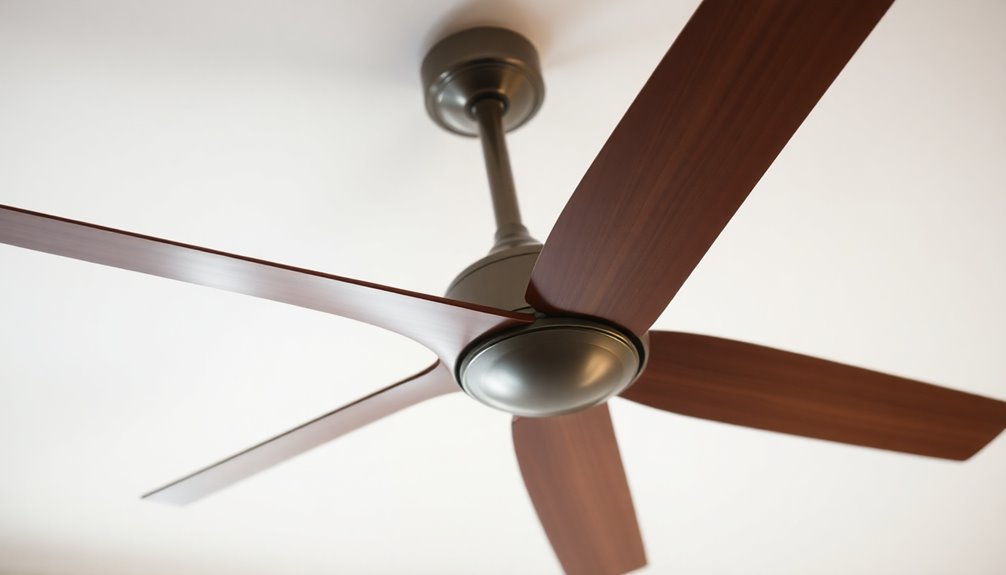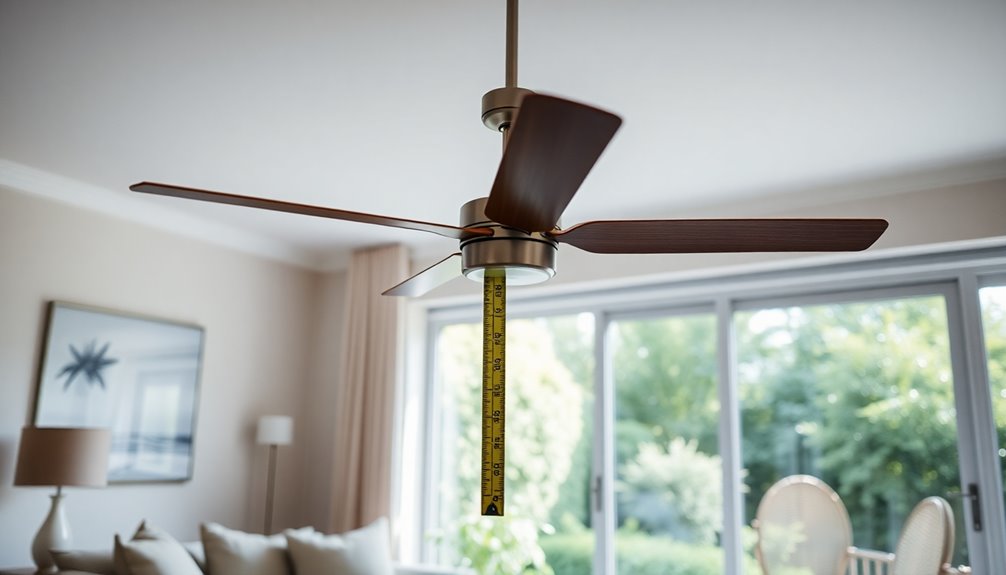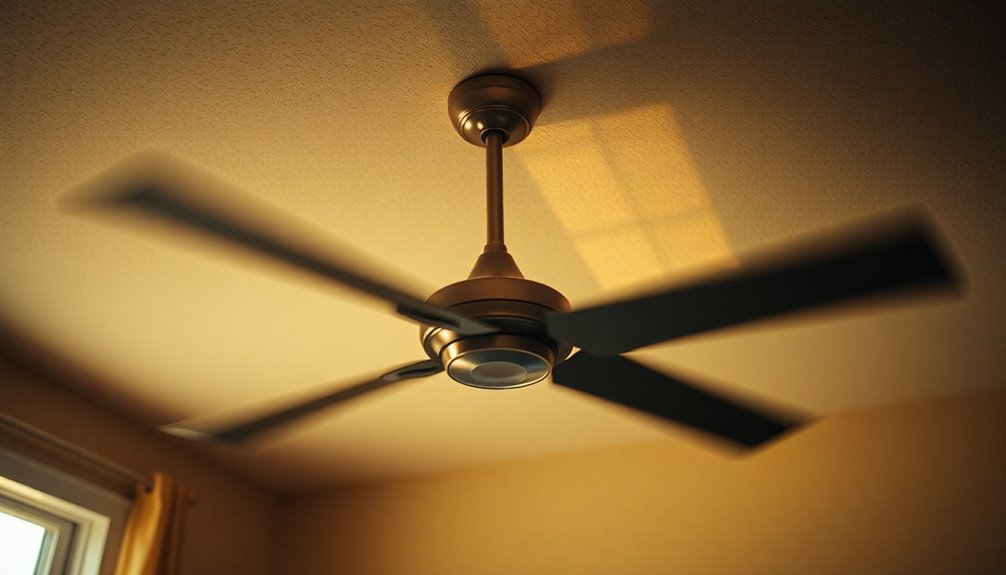To get the most out of your ceiling fan, set it to turn counterclockwise in the summer for a cooling breeze that helps reduce air conditioning costs. In the winter, switch it to clockwise to gently push warm air down, avoiding cold spots and saving on heating bills. You should make these adjustments during Daylight Savings Time—counterclockwise in spring and clockwise in fall. Always turn off the fan before changing directions. Following these simple guidelines can enhance your comfort and save energy. There's even more to explore about optimizing your fan's performance and efficiency.
Key Takeaways
- In summer, ceiling fans should turn counterclockwise to create a cooling downdraft and enhance comfort.
- In winter, switch fans to clockwise to redistribute warm air and eliminate cold spots.
- Adjust fan direction in spring and fall to coincide with Daylight Savings Time changes.
- Always ensure the fan is turned off before changing its direction for safety.
- Regular maintenance and cleaning help ensure optimal performance and efficiency of ceiling fans.
Importance of Ceiling Fan Direction

The direction of your ceiling fan is essential for maximizing comfort and energy efficiency in your home. When you set your fan to summer mode, it should spin counterclockwise. This direction creates a cooling downdraft, enhancing airflow and generating a rejuvenating wind chill effect.
You'll find that you can raise your thermostat settings, ultimately reducing your energy costs during those hot months.
In winter mode, switch the fan to rotate clockwise. This adjustment creates an updraft that redistributes warm air, helping maintain a consistent temperature throughout your space.
By effectively circulating warm air, you can potentially cut heating costs by up to 15%.
If your ceiling fan direction is incorrect, you might experience uncomfortable indoor conditions. Inadequate airflow can hinder the effectiveness of your cooling and heating systems, leading to higher energy costs.
Making seasonal adjustments to your fan direction is a simple yet impactful way to enhance comfort and optimize energy usage. Properly using your fan can save you up to 30% on cooling costs and 15% on heating bills, proving that fan spinning in the right direction truly matters.
Seasonal Fan Direction Guidelines

To guarantee your ceiling fan operates efficiently throughout the year, it's crucial to adjust its direction as the seasons change.
By following the right seasonal fan direction guidelines, you can enhance comfort and lower energy bills.
1. Summer (Spring and Summer): Set your ceiling fan direction to counterclockwise. This creates a cooling downdraft, maximizing the wind chill effect and making your space feel cooler.
This adjustment can reduce energy bills by up to 30%.
2. Winter (Fall and Winter): Change the direction to clockwise. This setting helps circulate warm air from the ceiling back down into the living area, ensuring that your space stays warm and cozy.
You could save 15% or more on heating costs with this simple switch.
3. Daylight Savings Time: Consider changing the fan direction during these adjustments.
When the clocks spring forward, switch to counterclockwise; when they fall back, switch to clockwise.
Changing Ceiling Fan Direction

When you're ready to change the direction of your ceiling fan, first verify it's turned off and completely stopped to avoid any accidents.
For fans with a pull chain, locate the ceiling fan direction switch on the fan body. This toggle allows you to turn the fan clockwise or counterclockwise, which helps keep your space comfortable during both summer and winter months.
If you have a remote-controlled fan, make sure the remote is paired. Turn off the fan, then press and hold the fan button until you see a light blink on the remote. This indicates it's ready to change the ceiling fan direction.
For smart fans equipped with SIMPLEconnect® WiFi® technology, you can easily change your ceiling fan direction through an app or even by using voice commands.
Once you've made the adjustment, don't forget to turn the fan back on to guarantee it operates in the newly selected direction.
Depending on the season, turning counterclockwise will create a cooling breeze in summer, while turning clockwise will help circulate warm air in winter.
Enjoy your newly configured comfort!
Timing for Direction Change

Adjusting your ceiling fan direction at the right times can greatly enhance your comfort throughout the year.
Timing your changes is key to maximizing both airflow and energy efficiency. Consider the following:
- Spring Forward: When Daylight Savings Time begins in the spring, switch your fan to rotate counterclockwise. This direction caters to your cooling needs during the summer months, creating a revitalizing breeze that helps lower the temperature in your space.
- Fall Back: As Daylight Savings Time ends in the fall, change the fan direction to clockwise. This adjustment helps circulate warm air during the winter, maintaining a cozy atmosphere while reducing heating costs.
- Room Size: Make sure your ceiling fan size is appropriate for the room.
A well-sized fan works more effectively, enhancing airflow and temperature control, ultimately improving your comfort year-round.
Ceiling Fan Direction in Summer

In summer, you should set your ceiling fan to rotate counterclockwise to create a revitalizing downdraft.
This not only enhances the cooling wind chill effect, making your space feel more comfortable, but it can also help cut your energy costs by reducing reliance on air conditioning.
Adjusting your fan this way is a quick and easy step toward improving your comfort and efficiency.
Cooling Wind Chill Effect
The cooling wind chill effect of a ceiling fan operating in summer can transform your indoor environment, making it feel noticeably cooler without the need for excessive air conditioning.
By setting your ceiling fan to rotate counterclockwise, you create a cooling downdraft that enhances airflow, allowing the fan to produce a rejuvenating breeze. This breeze helps to evaporate moisture from your skin, amplifying the wind chill effect.
To maximize this effect, consider these three key factors:
- Blade Angle: Confirm the fan blades are at a minimum angle of 12 degrees for ideal airflow without disrupting other items in the room.
- Fan Speed: Running the fan at high speed can allow your thermostat to be set up to 4 degrees higher, promoting energy savings.
- Consistent Use: Properly using your ceiling fan reduces reliance on air conditioning, helping to maintain comfort while lowering air conditioning costs.
Energy Cost Reduction
Choosing the right ceiling fan direction in summer can greatly reduce your energy costs. By setting your ceiling fan to rotate counterclockwise, you create a cooling downdraft that can make your room feel up to 4 degrees cooler.
This simple adjustment can greatly enhance your cooling efficiency and lead to energy savings of up to 30% by reducing reliance on air conditioning. The wind chill effect produced by a counterclockwise fan allows you to raise your thermostat settings without sacrificing comfort.
While a ceiling fan typically consumes only about 50 watts, a standard air conditioning unit uses around 3,500 watts. This stark difference means you can enjoy a cooler environment while spending less on energy bills.
Additionally, pairing your ceiling fan with an ENERGY STAR certified air conditioner can boost cooling efficiency by up to 8%. This combination not only enhances comfort but also helps you keep your energy costs in check.
Ceiling Fan Direction in Winter

In winter, you should set your ceiling fan to run clockwise at a low speed.
This simple adjustment helps circulate warm air from the ceiling down into your living space, making it more comfortable and reducing cold spots.
Plus, it can save you up to 15% on heating bills, so it's definitely worth considering.
Clockwise Rotation Benefits
Ceiling fans can be a game changer during winter months when set to rotate clockwise. This simple adjustment creates a gentle updraft that helps redistribute warm air that collects near the ceiling.
Here are some key benefits of using your ceiling fan in this way:
- Enhanced Comfort: A clockwise rotation allows warm air to flow down into your living space, maintaining a more consistent temperature without creating a chilly breeze.
- Energy Savings: You can enjoy energy savings of up to 15% on heating bills by lowering your thermostat while still feeling comfortable.
- Improved Efficiency: By reducing the workload on your heating systems, the ceiling fan helps improve efficiency, ensuring your furnace or heat pump works less while keeping you warm.
When standing directly beneath the fan, you shouldn't feel a noticeable breeze; instead, the air will feel still or slightly warmer.
This means your fan is effectively circulating warm air, making your home cozy and economical during the colder months. Implement this simple trick and enjoy a warmer, more efficient winter!
Heat Distribution Techniques
When temperatures drop, using heat distribution techniques can make a significant difference in your comfort level at home. To maximize warmth during the colder months, adjust your ceiling fan direction to rotate clockwise at a low speed. This gentle updraft pulls warm air from the ceiling down into your living space, effectively redistributing heat and eliminating cold spots.
By running your fan in this way, you'll create a more consistent temperature throughout the room. You won't even notice a downward breeze, which signifies that your fan is operating correctly for heat distribution. This simple adjustment can help you feel cozier without cranking up your heating system.
As a bonus, utilizing your ceiling fan in this manner can lead to heating bill savings, allowing you to lower your thermostat settings while still enjoying a warm environment.
In fact, many people experience reductions of 15% or more on their heating bills just by making this one change. So, take advantage of your ceiling fan this winter; it's a straightforward way to stay warm and comfortable while also being energy-efficient.
Energy Bill Savings
Adjusting your ceiling fan to rotate clockwise in winter not only enhances heat distribution but can also lead to significant energy bill savings.
By creating a gentle updraft, the fan helps to redistribute warm air trapped near the ceiling, improving your home's heating efficiency.
Here's how you can maximize your energy savings:
- Lower Thermostat Settings: With the ceiling fan running clockwise at low speed, you can reduce your thermostat setting by a few degrees without sacrificing comfort. This adjustment can lead to utility bill reductions of up to 15%.
- Cost-Effective Heating: Ceiling fans consume about 50 watts, a fraction of the 3,500 watts typically used by electric heating systems. Using your fan is a cost-effective way to maintain warmth.
- Eliminate Cold Spots: Effective air movement helps eliminate cold spots, contributing to a more consistent and comfortable indoor temperature throughout the winter months. Additionally, using a ceiling fan can enhance airflow efficiency, making your heating system work more effectively.
Ceiling Fan Direction for Specific Rooms

Typically, the direction you set your ceiling fan can greatly impact comfort in different rooms. For vaulted ceilings, keep your fan running counterclockwise year-round. This setting minimizes wind chill and maintains comfortable airflow throughout the space.
In dining rooms, set the fan to clockwise at medium or low speed. This helps avoid cooling your food too quickly while still circulating warm air effectively.
If you're working in a home office, a medium clockwise setting is ideal. It prevents papers from blowing around while helping to distribute warm air, creating a more productive environment.
For smokers, running the fan clockwise can be beneficial as it draws smoke upward, improving ventilation, especially when paired with open windows.
When it comes to outdoor fans, adjusting to counterclockwise at high speed enhances air circulation and aids in insect control, making your outdoor space more enjoyable.
General Ceiling Fan Tips

How can you maximize the efficiency of your ceiling fan? Start by understanding the right ceiling fan direction for each season. In the summer, set the ceiling fan to spin counterclockwise to create a downdraft that helps keep you cool. In winter, reverse the direction to circulate warm air near the ceiling.
Here are three essential tips to maintain your fan's efficiency:
- Regular Cleaning: Dust and grime can accumulate on the blades and motor. Regular cleaning is crucial to guarantee peak performance and reduce energy consumption.
- Turn the Fan Off When You Leave: Remember, ceiling fans don't cool the air; they create a wind chill effect. Turning off the fan when you exit the room helps save energy.
- Use a Remote Control: Installing a remote control simplifies operation, allowing you to easily change the fan's direction seasonally.
If you notice little to no air movement while the fan is running, it may indicate a failing motor or improper blade pitch, so don't hesitate to seek maintenance or replacement.
Following these tips will help you maintain efficiency and enjoy a comfortable environment.
Energy Savings With Ceiling Fans

Ceiling fans are a smart investment for anyone looking to cut down on energy costs while staying comfortable throughout the year.
In the summer, setting your ceiling fan direction to counterclockwise allows it to circulate cool air effectively, which can save you up to 30% on cooling costs. This simple adjustment can make a significant difference in your utility bill, especially when using best air flow ceiling fans.
In winter, running your ceiling fan clockwise at low speed helps redistribute warm air without creating uncomfortable drafts, potentially reducing your energy bill by 15% or more.
With a ceiling fan using only about 50 watts compared to the hefty 3,500 watts of a central air conditioning unit, it's a highly efficient cooling alternative.
To maximize energy savings, consider pairing your ceiling fan with an ENERGY STAR-certified air conditioning system; this can enhance overall efficiency by up to 8%. Additionally, regular maintenance of your heat pump system can further improve energy efficiency and reduce operational costs.
By making seasonal adjustments to your ceiling fan direction, you can impact your comfort levels and energy consumption throughout the year.
With these strategies in mind, your ceiling fan can help you enjoy a comfortable home while keeping your energy costs in check.
Frequently Asked Questions
Which Way Is a Ceiling Fan Supposed to Turn in the Summer?
In the summer, your ceiling fan should turn counterclockwise.
This direction creates a cool downdraft that enhances air circulation, making your room feel cooler. You can increase your thermostat settings by up to 4 degrees and still stay comfortable.
Plus, running the fan this way can cut your energy costs by up to 30% compared to using only air conditioning.
Just stand beneath it to feel the invigorating breeze!
Which Way Should a Ceiling Fan Turn in Summer Reddit?
When you're standing beneath a ceiling fan, it should feel like an invigorating breeze on a hot day.
On Reddit, you'll find that the consensus is clear: during summer, your ceiling fan needs to spin counterclockwise. This direction creates a cooling downdraft, making the room feel cooler while saving energy.
Just check for the airflow with your hand, and if it's not right, flip that switch or use the remote to adjust it!
What Direction Should I Face My Fan?
When deciding which direction to face your fan, consider where you spend the most time. Position it to blow air directly toward you for maximum comfort.
If you're looking to enhance airflow in a larger room, angle it slightly to circulate the air throughout the space.
Don't forget to think about the seasons; adjusting the fan's rotation can make a significant difference in your comfort level and energy efficiency.
Why Not Use AC and Fan Together?
Imagine stepping into a cool oasis on a sweltering day, where the air flows gently around you.
You're missing out if you're not using an AC and a ceiling fan together! This powerful duo circulates the cool air, letting you set your thermostat higher and saving energy.
With a fan's low wattage, you reduce strain on the AC, prolonging its life while enjoying a revitalizing breeze every day.
Why not embrace that comfort?
Conclusion
In the swirling dance of seasons, adjusting your ceiling fan's direction can make all the difference. By setting it to spin counterclockwise in the summer, you create a invigorating breeze that cools you down, like a gentle summer wind rustling through leaves. When winter arrives, switch it to clockwise to circulate warm air, wrapping your space in cozy warmth. So, embrace the power of your ceiling fan, and let it transform your comfort year-round while saving energy!









